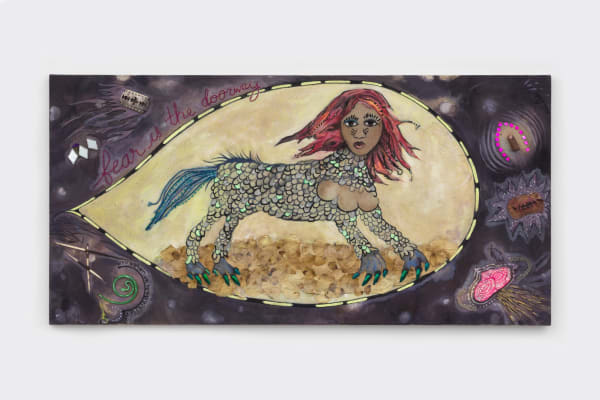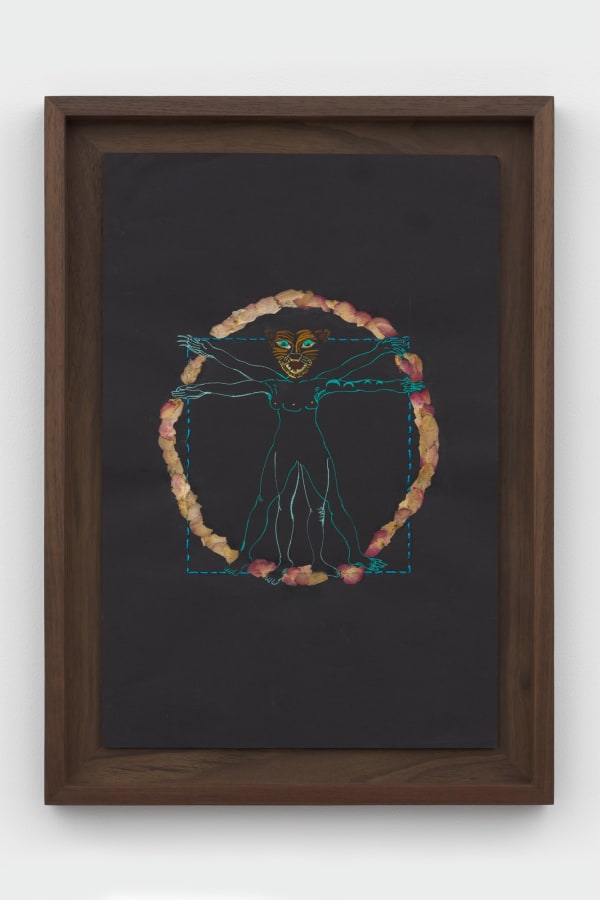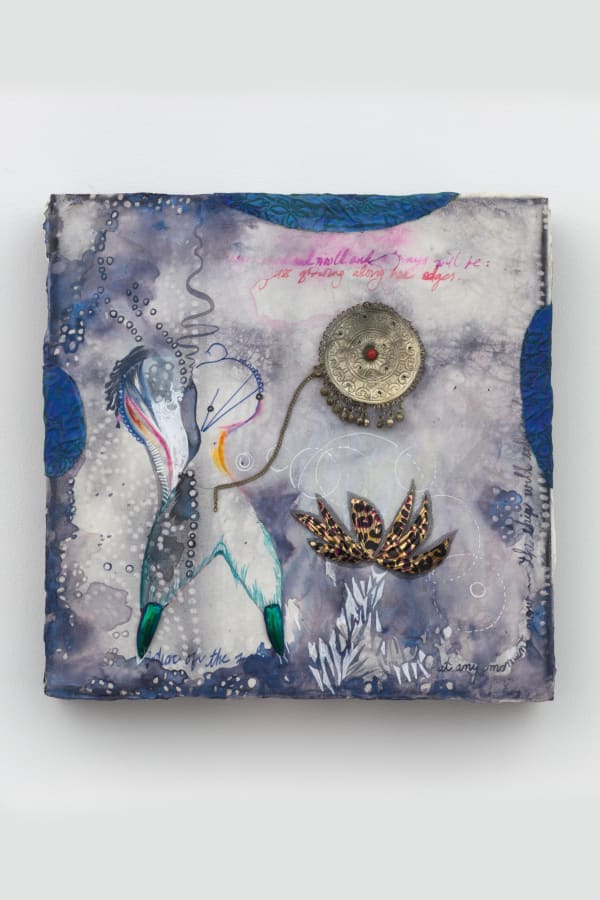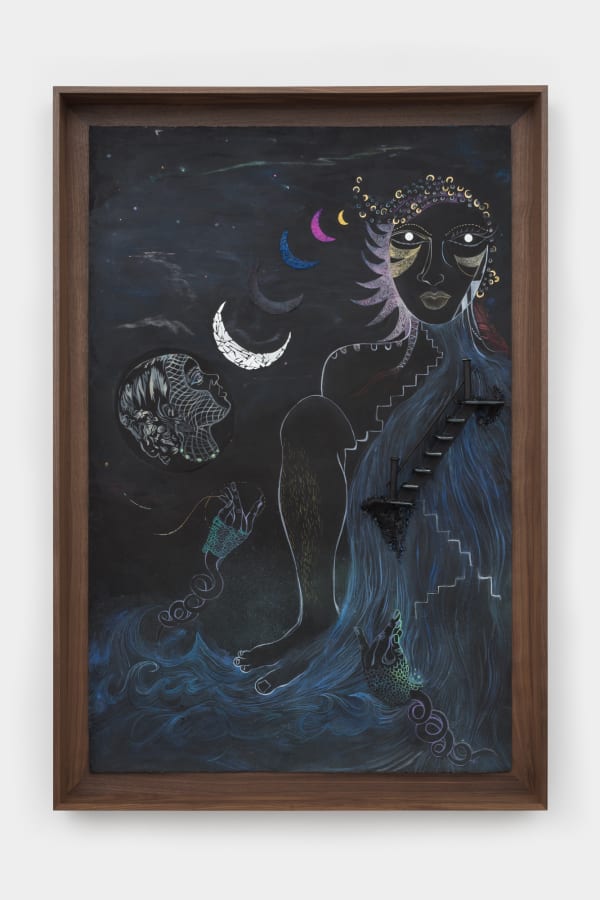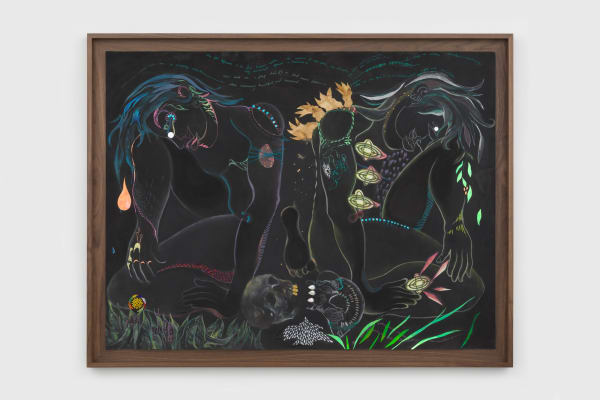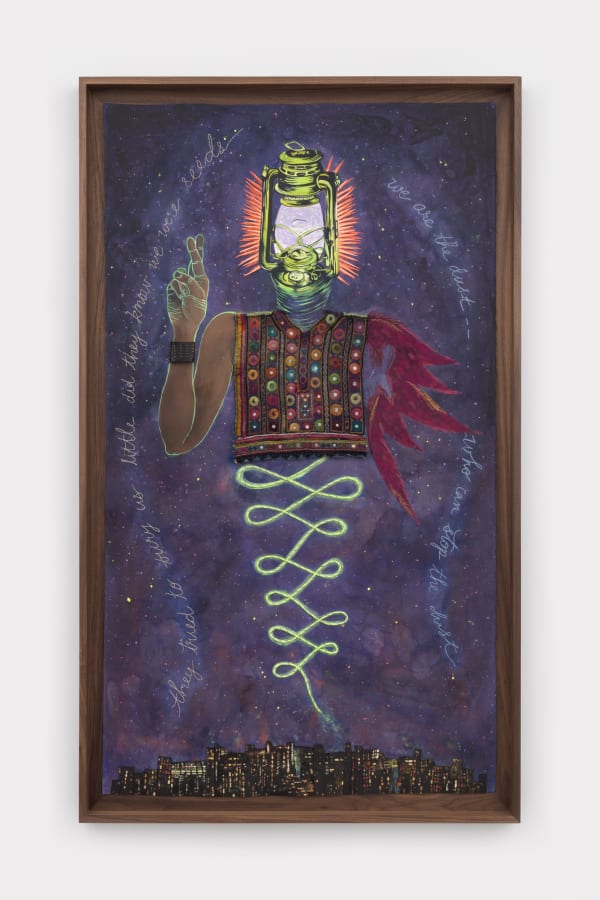Chitra Ganesh: Nightswimmers
Hales is delighted to announce Nightswimmers, the gallery’s first solo exhibition of works by Chitra Ganesh (b. 1975 Brooklyn, New York, USA). Ganesh received a BA in Art-Semiotics and Comparative Literature from Brown University, Providence, RI in 1996 and an MFA in Visual Arts from Columbia University, NY in 2002. She lives and works in Brooklyn, NY, USA.
Across a twenty-year practice, Chitra Ganesh has developed an expansive body of work rooted in drawing and painting, which has evolved to encompass animations, wall drawings, collages, computer generated imagery, video, and sculpture. In extraordinary epic works, Ganesh combines a vast array of influences including South Asian iconography, science fiction and queer theory, with the visual languages of vintage comics, sign painting, Bollywood posters, and video games. Through a multidisciplinary approach, Ganesh has “catalysed a long- standing investigation of narrative and imagery anchored in historical South Asia and extending to contemporary global concerns. Her work challenges and disrupts conventions of gender, sexuality and power, particularly by centering or reorienting complex narratives – often of mythological or epic proportion – around iconic female protagonists and forms.”[1]
Nightswimmers continues Ganesh’s immersive practice of kaleidoscopic experiments. In complex investigations of the social and physical body, she layers drawings, sculptural elements, and visual imagery with her own writing — an intricate process of intertwining different forms. Words dance across the surface in works such as Svati (Then & Now) and Mother, the sentences float as if protecting the luminous figures below. In poetic musings she is inspired by instances of opposition and dissent, often drawing from first person testimony as well as proverbs and protest songs, such as the phrase, ‘They tried to bury us, they didn’t know we were seeds.’ First noticing the slogan at protests against India's current government and its Hindu nationalist policies of targeted surveillance, the words have been notably linked to the ‘Families Belong Together’ campaign in the US — a response to government policy separating children from parents.[2] Ganesh’s longstanding exploration of the language and aesthetic of political acts of resistance feeds into all the facets of her practice.
In these new works for Nightswimmers, Ganesh creates beautiful respite, weaving everyday life with the magical, speaking to quiet, playful moments of human connection. The erotic runs as a current through all of the pieces, as a great source of power and creative energy that is physical and psychic.[3] Women are depicted nude and relaxed, lounging by water and swimming together, there is a spiritual grounding in nature. Their bodies are often in a state of becoming – heads turn into animals, trees and flowers, in mystical scenes full of fantastical elements. As well as whole figures, specific body parts are repeated in the works. These come from close readings of bodily movements, particularly of hand gestures and the many things they can symbolize, such as defiance, surrender, openness and care. Eyes repeat throughout the works to represent multiple realms of visibility and ways of seeing. There is an erotic connection to both the physical and spiritual body.
Exploring the transient nature of things, including states of mind and the body itself, Ganesh has long been fascinated by visual imagery that represents the liminal space between life and death. This theme emerged when developing her solo exhibition at the Rubin Museum, NY in 2018. Death Dancer (2021) continues this thread of her practice, depicting a guardian of the underworld, directly referencing the Citipati, a Tibetan deity, who symbolizes the eternal dance of death. Developing her own iconographies, she plays with archetypal subjects, such as the Vitruvian man, which becomes a three-breasted figure surrounded by rose petals. In Mother (2021) a girl is surrounded by thought bubbles which repeat the words ‘Mother’ pronounced Amma in the Tamil language. This work was extracted from a longer comic-style piece made at the beginning of the pandemic, entitled Anima Mundi. In nonlinear narratives and richly layered visual worlds, Ganesh subverts traditional storytelling to create femme and queer-centric narratives. Each work, a moment in an epic, woven from everyday stories and everyday materials, draws the viewer into her alternate reality.
Ganesh's work has been widely exhibited in the United States and internationally, including solo shows at Brooklyn Museum, NY,USA; MoMA PS1, NY, USA; The Kitchen, NY, USA; The Rubin Museum of Art, NY, USA; The Andy Warhol Museum, PA, USA; Gothenburg Kunsthalle, Sweden; and Times Square, NY, USA. Her work has also been exhibited in important group exhibitions at The Walker Art Center, MN, USA; the Baltimore Museum of Art, MD, USA; The Queens Museum of Art, NY, USA; The Asia Society, NY, USA; The Bronx Museum, NY, USA; The Contemporary Arts Museum, Houston, TX, USA; the Berkeley Art Museum and Pacific Film Archive, CA, USA; the Museum of Contemporary Art San Diego, CA, USA; the Boca Raton Museum of Art, LA, USA; the Hayward Gallery, London, UK; Saatchi Museum, London, UK: Fondazione Sandretto Re Rebaudengo, Italy; Instituto Valenciano de Arte Moderno, Italy; the ZKM Center for Art and Media, Germany; Göteborgs Konsthall, Germany; Arthotek Kunstverein, Göttingen, Germany; the Museum of Contemporary Art, Shanghai, China; the Gwangju Contemporary Arts Centre, Korea; the Prince of Wales Museum, Mumbai, India; Indira Ghandi National Centre for Arts, New Delhi, India; Devi Art Foundation, India; the Kochi Biennial, India; the Dhaka Art Summit, Bangladesh among others.
Ganesh’s work is represented in the collections of the Museum of Modern Art, NY, USA; San Francisco Museum of Modern Art, CA, USA; the Whitney Museum of American Art, NY, USA; The Brooklyn Museum, NY, USA; The Art Institute of Chicago, IL, USA; the Baltimore Museum of Art, MD, USA; Smithsonian American Art Museum, Washington, DC; The Ford Foundation, NY, USA; University of Michigan Museum of Art, MI, USA; San Jose Museum of Art, The Philadelphia Museum of Art, PA, USA; the Devi Art Foundation, India; Kiran Nadar Museum, Delhi, India; the Saatchi Collection, London, UK; Burger Collection, Hong Kong; Deutsche Bank, among others.
[1] Citron, Beth. (2019) Numero Art
[2] Xiao, An. On the Origins of “They Tried to Bury Us, They Didn’t Know We Were Seeds” https://hyperallergic.com/449930/on-the-origins-of-they-tried-to-bury-us-they-didnt-know-we-were-seeds/
[3] Audre Lorde, Uses of the Erotic: The Erotic as Power in Sister Outsider, 1984


